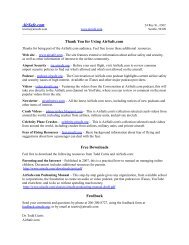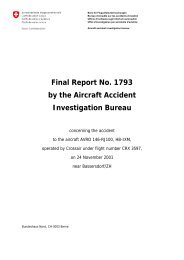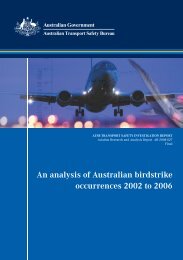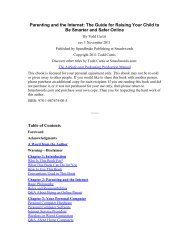AAIB Investigation Updates (PDF) - Airline Safety and Security ...
AAIB Investigation Updates (PDF) - Airline Safety and Security ...
AAIB Investigation Updates (PDF) - Airline Safety and Security ...
You also want an ePaper? Increase the reach of your titles
YUMPU automatically turns print PDFs into web optimized ePapers that Google loves.
<strong>AAIB</strong> Interim Report 2 G-YMMM EW/C2008/01/01<br />
which resulted in a change in the equilibrium between<br />
the cold fuel <strong>and</strong> hot oil in the heat exchanger, such that<br />
the ice melted on the inlet face of the FOHE, sufficient<br />
to restore the dem<strong>and</strong>ed fuel flow.<br />
Further testing has established that 25 ml of water, when<br />
introduced into the fuel flow at the boost pump inlet at<br />
an extremely high concentration, can form sufficient ice<br />
to restrict the fuel flow through the FOHE. During these<br />
tests it was concluded that it was not possible to restrict<br />
the fuel flow through the FOHE when the temperature of<br />
the fuel in the main tank was above ‐15°C (5°F) at a fuel<br />
flow of 6,000 pounds per hour (pph) <strong>and</strong> ‐10°C (14°F) at<br />
a fuel flow of 12,000 pph.<br />
It should be emphasised that the FOHE, which is part of<br />
the engine fuel system, was shown to comply with all<br />
the requirements placed on the engine manufacturer at<br />
the time of certification; the tests conducted in the course<br />
of the investigation have not, to the knowledge of the<br />
<strong>AAIB</strong>, been proposed or conducted before.<br />
Further testing<br />
Since the publication of the <strong>AAIB</strong> initial interim report<br />
the aircraft manufacturer has undertaken further testing<br />
on a fuel rig to establish how ice might accumulate in the<br />
aircraft fuel feed system.<br />
Blockage in the aircraft fuel feed system<br />
During the testing, blockage of the fuel boost pump<br />
inlet screen was achieved on six occasions sufficient<br />
to restrict the flow. The restrictions occurred during the<br />
testing <strong>and</strong> were believed to have occurred as a result of<br />
the method by which water was introduced into the fuel<br />
to maintain the required concentration; consequently<br />
these restrictions were believed to be an artefact of the<br />
test set-up. The restrictions were all characterised by a<br />
drop in the fuel pressure, sufficient to generate the boost<br />
pump low fuel pressure warning, <strong>and</strong> a reduction in the<br />
electrical current draw of the boost pump. The data<br />
from the accident flight showed that the boost pump low<br />
pressure switches did not trigger throughout the flight,<br />
therefore, icing of the inlet screens is unlikely to have<br />
caused the particular fuel flow restrictions experienced<br />
on G‐YMMM.<br />
Observations from the earlier tests showed that, apart<br />
from the inlet screens <strong>and</strong> the FOHE, restrictions did<br />
not occur in any of the other fuel system components,<br />
or in any of the aircraft fuel feed pipes. During some<br />
of the long‐duration tests it was observed that, at a low<br />
fuel flow, ice could accumulate on the inside of the pipe<br />
walls. It was suspected that this ice would clear when<br />
the fuel flow was increased. However, on these early<br />
tests the geometry, material <strong>and</strong> lengths of the pipes on<br />
the fuel rig were not identical to the aircraft installation,<br />
nor were they exposed to the same environment as<br />
experienced on the accident flight.<br />
Ice accumulation tests<br />
To establish how ice might have accumulated within the<br />
fuel feed system on the accident flight, the fuel rig was<br />
reconfigured to include the majority of the right fuel system<br />
feed pipes from G‐YMMM. The pipes were arranged so<br />
that their gradients were representative of the attitude of<br />
the aircraft in the cruise. An environmental tank, filled<br />
with cold fuel, was used to simulate the environment<br />
surrounding the fuel feed pipes in the main fuel tank. An<br />
insulated box was built around those fuel pipes which<br />
pass through the centre ‘cheek’ tanks <strong>and</strong> dry ice was used<br />
to control the temperature in this area. The pipes located<br />
along the top of the strut (engine pylon) were exposed<br />
to the ambient conditions of the building in which the<br />
fuel rig was located; thermal modelling by the aircraft<br />
manufacturer indicated that this would approximate to the<br />
temperature in this area during the cruise.<br />
© Crown copyright 2009<br />
3











